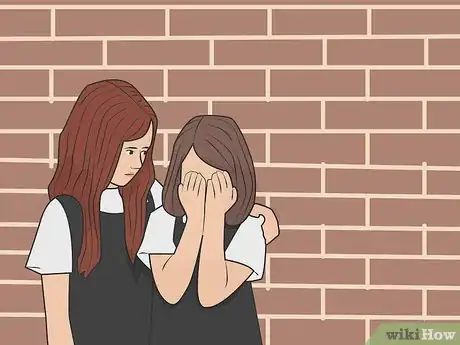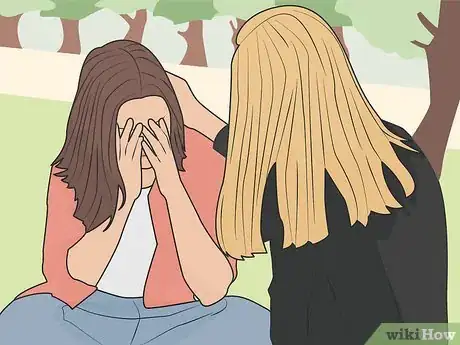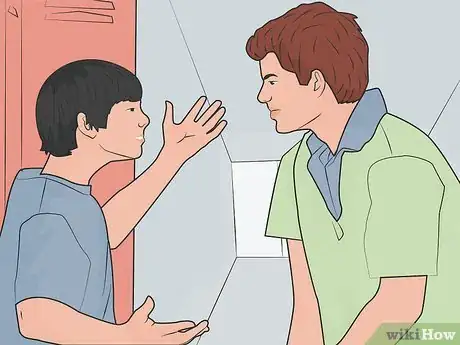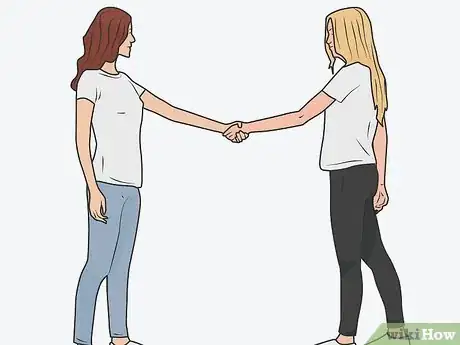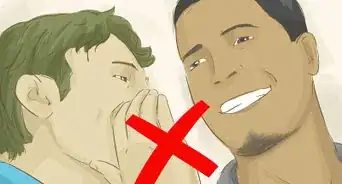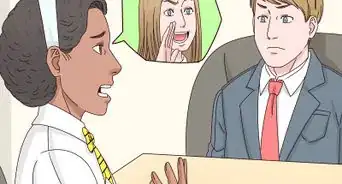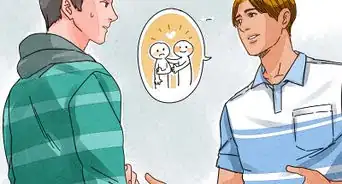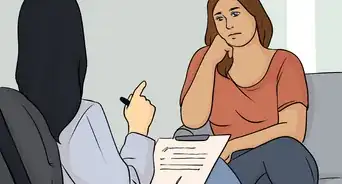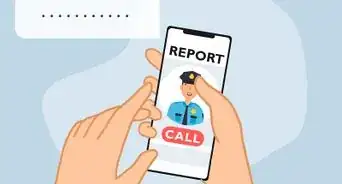This article was co-authored by Allison Broennimann, PhD. Dr. Allison Broennimann is a licensed Clinical Psychologist with a private practice based in the San Francisco Bay Area providing psychotherapy and neuropsychology services. With over a decade of experience, Dr. Broennimann specializes in in-depth psychotherapy to provide solution-focused treatments for anxiety, depression, relationship problems, grief, adjustment problems, traumatic stress, and phase-of-life transitions. And as part of her neuropsychology practice, she integrates depth psychotherapy and cognitive rehabilitation for those recovering after traumatic brain injury. Dr. Broennimann holds a BA in Psychology from the University of California, Santa Cruz, and an MS and Ph.D. in Clinical Psychology from Palo Alto University. She is licensed by the California Board of Psychology and is a member of the American Psychological Association.
There are 7 references cited in this article, which can be found at the bottom of the page.
wikiHow marks an article as reader-approved once it receives enough positive feedback. In this case, several readers have written to tell us that this article was helpful to them, earning it our reader-approved status.
This article has been viewed 228,791 times.
Bullying is a major problem, but it’s one that you can help stop. People who bully may appear powerful. They may be popular or physically intimidating, but they are neither as confident nor powerful as they seem. Often people who bully secretly feel insecure and powerless. They bully to appear strong in the eyes of others. When you stand up to them and show support for a friend or peer who is being bullied, you take control away from those who want to bully.[1] By learning how to react when you witness bullying, you can make a huge difference in the lives of others.
Steps
Supporting Someone Who’s Being Bullied
-
1Position yourself as close to a person being bullied as possible. People tend to move away when bullying happens. Fleeing the scene leaves the person being bullied alone, vulnerable, and embarrassed, as they become more visible to onlookers. Instead, move towards the person being bullied and sit, walk, or stand alongside them.
- If a close friend is being bullied, make arrangements, so you can be with them in situations where bullying typically happens. For example, you can plan to walk with them in-between classes or on the way to school.[2]
- Even if you don’t know the person being bullied, move towards and stand with them. Showing bravery in these situations breaks the “spell” that bullying can cast on bystanders. Many of your peers want to do the right thing but are too afraid. If you take the first step, some will follow. [3]
- If you sense that you might get hurt, leave and go quickly to get an adult.
-
2Ignore the person who’s acting like a bully. Most instances of verbal bullying can be handled by ignoring it. People who bully want attention, so they are hoping that bystanders will stop and watch. If you ignore bullying behavior, you deprive them from getting what they want, and they will often stop.
- Even if someone who’s bullying says something funny or clever, never laugh or respond positively.
- If you witness cyberbullying, never share these negative posts.
Advertisement -
3Encourage others to support the person being bullied. As soon as you notice bullying occurring, turn to the people around you and let them know that the behavior you’re witnessing isn’t right. Then indicate that you all need to do something to stop it. Simple cues can help others overcome fear and do the right thing.[4]
- First identify the behavior as wrong. You can say something like: “This isn’t right,” “That’s messed up,” or “This has gone too far.”
- Next invite others to help you stop the bullying: “We can’t let this go on,” “Let’s help them out,” or “We have to do something.”
- As you start to move towards the person being bullied, gesture for others to come with you.
-
4Shift the focus away from bullying. When bullying happens, people tend to freeze up and wait to see what will happen next. Instead of watching passively, you can determine what happens next and redirect everyone towards something positive. Change the subject or create a diversion and try to include the person being bullied in a positive way.
- You can say things like, “this is too much drama for a Monday.” Or “the bell’s about to ring. Let’s go.”
- Try to compliment the person being bullied in some way.
- Engage the person being bullied in conversation. Even if you don’t know the person well, you can ask them if they saw a recent movie or have weekend plans.
- If you’re struggling to find something to say and things are heating up, create a diversion. Spill a bottle of water, drop your books, slam a locker, or set off a timer. Diversions break the tension and let everyone reevaluate what to do.
-
5Leave with the person being bullied. Often the best way to diffuse a bullying situation is to help the person being bullied get away—especially if the bullying has attracted a large audience and things are getting tense. Encourage the person being bullied to leave with you and walk in the direction of an adult.
- You can say something simple like: “hey, let’s get out of here.”
- Asking the person being bullied for help with something is a great strategy. You ask for help with last-minute homework, ask them to come with you on an errand, or even pretend that you lost something and need their help finding it.
-
6Reassure the person being bullied that it’s not their fault. It can be hard not to take bullying to heart. Tell the person that’s being bullied that the problem is not with them. Just reminding them that bullies are the ones who feel insecure can be a real help.
- Say something like,"You're really strong. The bully is the one who's weak because they need to pick on people to feel good. It’s not cool."
- Validate what they've gone through—let them know that it's okay if they feel upset about it. It can help to name out loud which parts of the experience were intimidation, bullying, or abuse.[5]
- Encourage them to tell an adult and offer to go with them when they report it.[6]
Intervening to Stop Acts of Bullying
-
1Use confident body language when addressing someone who’s bullying. You don’t have to confront a bully if you don’t feel safe. But if you feel comfortable, make sure that you are facing them. Stand with good posture—making yourself as tall as possible. Look them directly in the eyes to communicate confidence.
-
2Tell the bully to stop. Once you have their attention, communicate clearly to the person who’s bullying and simply tell them to stop. Make sure that your voice is assertive yet calm and collected. [7]
- You can simply say, "What you're doing isn't cool. Please stop." Or you could say, "I don't like how you're treating my friend. Stop."
- Avoid yelling or retaliating. You don’t want to hurt a bully’s feelings. Most bullies are struggling themselves, so treat them with respect.
- If you’re witnessing cyberbullying, you can send the bully a private message that says you know what's going on and they need to stop.
-
3Deescalate the situation as quickly as possible. When you confront a person who’s bullying, they may feel ashamed and upset since their attempt to appear powerful and in control has failed. Do everything you can to help the person who was bullying save face and have time to think about their actions without being publicly humiliated themselves.
- The most effective approach is simply to leave (with the person who was being bullied) after intervening.
- You may also want to help the person who was bullying save face by saying something like: “I know you were just joking. Let’s all take a breather” before you leave.
- If you feel comfortable, check in with the person who was bullying later on in the day. Let them know that even though you don’t tolerate bullying, you know they are good a person.
Reporting Bullying to an Adult or Administrator
-
1Document instances of bullying. After you witness someone bullying a friend or peer, write down what you saw, heard, and felt as well as additional details about what led up to the event. If you have a cell phone or other recording device and are in a location where you can use it, record what’s happening.
- Try to write down what happened as soon as possible after the event. Our memories get worse as times passes.
- Include the names of other witnesses, the date and time of the event, and the location.
- Try to include what each individual said and did leading up to and during the event.
- Consider asking other witnesses to tell you what they observed and write that down too.
-
2Share what you saw with a trusted adult. As soon as you can, talk to an authority figure you trust.[8] Tell your parent, a teacher, a counselor, school nurse, or visit the school office and ask to meet with the principal. Share a copy of your documentation with them.[9]
- Report bullying whether it happens at school, online, or elsewhere.
-
3Follow up after reporting to make sure action was taken. Adults and administrators are not perfect, and sometimes really important things—like stopping bullying—can get forgotten. Check in a few days after reporting bullying and ask if action was taken or any other information from you is needed. If you are not getting anywhere, tell a different adult or administrator.
- If bullying continues to be an issue in your school or community, continue to write down what’s happening and follow up with adults and administrators.
Working Together to Prevent Bullying
-
1Make sure that common targets of bullying feel included. People who bully often pick on people who are already experiencing social exclusion or are unique in some way. These groups make easy targets because they may stand out or appear relatively defenseless. A great way to prevent bullying before it starts is to make an effort to include and befriend people who might otherwise become the target of bullying.
- If you see someone eating alone at lunch or walking by themselves, ask them to join you.
- Certain groups of people such as LGBTQ youth, people with disabilities, or members of minority groups frequently become the targets of bullying. Bullying is hard on anyone, but because members of these groups typically experience more bullying than others, it’s important to make sure you look out for them.
-
2Forgive and include people who have bullied others. Don’t make the mistake of judging someone who bullies as a bad person. Never try to bully them back or retaliate. [10] Most people who bully just want attention but are going about it in the wrong way. Help them find a more positive way to interact with others.[11]
- If possible, try to compliment, include, or even befriend the person who bullied.
- You can either just pretend the bullying did not happen and strike up an unrelated conversation with the bully at a later date.
- Or you can address the situation by saying something like, “I realize it got a little tense back there, but I hope we can just let that go and get along with each other.”
-
3Form a committee or club to address bullying on an on-going basis. You won’t end bullying with a single action or event. Reading articles like this one and standing up to bullying when it happens are excellent steps to take, but if you want to really end bullying in your community or school, it requires an organized approach. Ask a teacher or parent to help you start a group that will focus on bullying.
- The committee can either be an informal group or an official school club, but it should include both students and adults.[12]
- Some important actions you can take include: mapping where bullying typically takes place and making sure those areas are better supervised, holding regular assemblies to raise awareness, and making sure that your school or organization have firm rules and guidelines for addressing bullying.[13]
Expert Q&A
-
QuestionHow can I help someone cope with bullying?
 Allison Broennimann, PhDDr. Allison Broennimann is a licensed Clinical Psychologist with a private practice based in the San Francisco Bay Area providing psychotherapy and neuropsychology services. With over a decade of experience, Dr. Broennimann specializes in in-depth psychotherapy to provide solution-focused treatments for anxiety, depression, relationship problems, grief, adjustment problems, traumatic stress, and phase-of-life transitions. And as part of her neuropsychology practice, she integrates depth psychotherapy and cognitive rehabilitation for those recovering after traumatic brain injury. Dr. Broennimann holds a BA in Psychology from the University of California, Santa Cruz, and an MS and Ph.D. in Clinical Psychology from Palo Alto University. She is licensed by the California Board of Psychology and is a member of the American Psychological Association.
Allison Broennimann, PhDDr. Allison Broennimann is a licensed Clinical Psychologist with a private practice based in the San Francisco Bay Area providing psychotherapy and neuropsychology services. With over a decade of experience, Dr. Broennimann specializes in in-depth psychotherapy to provide solution-focused treatments for anxiety, depression, relationship problems, grief, adjustment problems, traumatic stress, and phase-of-life transitions. And as part of her neuropsychology practice, she integrates depth psychotherapy and cognitive rehabilitation for those recovering after traumatic brain injury. Dr. Broennimann holds a BA in Psychology from the University of California, Santa Cruz, and an MS and Ph.D. in Clinical Psychology from Palo Alto University. She is licensed by the California Board of Psychology and is a member of the American Psychological Association.
Clinical Psychologist First, validate what the person went through. Be curious about what happened, if they are willing to talk, and name out loud which parts were verbal, physical, or sexual intimidation, bullying, or abuse. Are there any trusted authorities to reach out to for protection or support? Also, work through the reasonable next steps for the bullied person to protect themselves in the moment.
First, validate what the person went through. Be curious about what happened, if they are willing to talk, and name out loud which parts were verbal, physical, or sexual intimidation, bullying, or abuse. Are there any trusted authorities to reach out to for protection or support? Also, work through the reasonable next steps for the bullied person to protect themselves in the moment.
Warnings
- Some forms of bullying can be very serious and must be addressed immediately by an authority figure. Seek out an adult immediately in any of the following cases:[14]
- Someone has a weapon
- Someone has threatened to seriously injure someone else
- There have been hate-motivated threats or actions (stemming from racism, homophobia, etc.)
- Someone has been sexually assaulted
- Someone is committing a crime (such as robbery or extortion)
⧼thumbs_response⧽
References
- ↑ http://www.greatschools.org/gk/articles/stamp-out-bullying/
- ↑ http://www.stopbullying.gov/respond/be-more-than-a-bystander/index.html
- ↑ http://www.stopbullying.gov/respond/be-more-than-a-bystander/index.html
- ↑ http://njbullying.org/documents/lendingahand.pdf
- ↑ Allison Broennimann, PhD. Clinical Psychologist. Expert Interview. 14 December 2020.
- ↑ http://njbullying.org/documents/lendingahand.pdf
- ↑ http://njbullying.org/documents/lendingahand.pdf
- ↑ Allison Broennimann, PhD. Clinical Psychologist. Expert Interview. 14 December 2020.
- ↑ http://njbullying.org/documents/lendingahand.pdf
- ↑ http://pbskids.org/itsmylife/friends/bullies/article6.html
- ↑ http://njbullying.org/documents/lendingahand.pdf
- ↑ http://www.stopbullying.gov/prevention/at-school/engage-parents/index.html
- ↑ http://www.greatschools.org/gk/articles/stamp-out-bullying/
- ↑ http://www.stopbullying.gov/respond/on-the-spot/index.html
About This Article
If someone is being bullied, it's important to help them deal with the situation, since they might not feel brave enough. If you notice someone being bullied, tell someone in charge, like a teacher or group leader. Let them know how long it's been going on and what the bullies have been doing. If you catch the bullies in the act but don't want to step in, record the scene so you can show it to an adult as evidence. If you want to try standing up to the bullies, say something like, “Hey, you can’t treat Ricky like that. Stop it.” You can also encourage the person to leave the situation. For instance, say, "Come on, let's get out of here." For more tips, including how to comfort someone who’s being bullied, read on.




